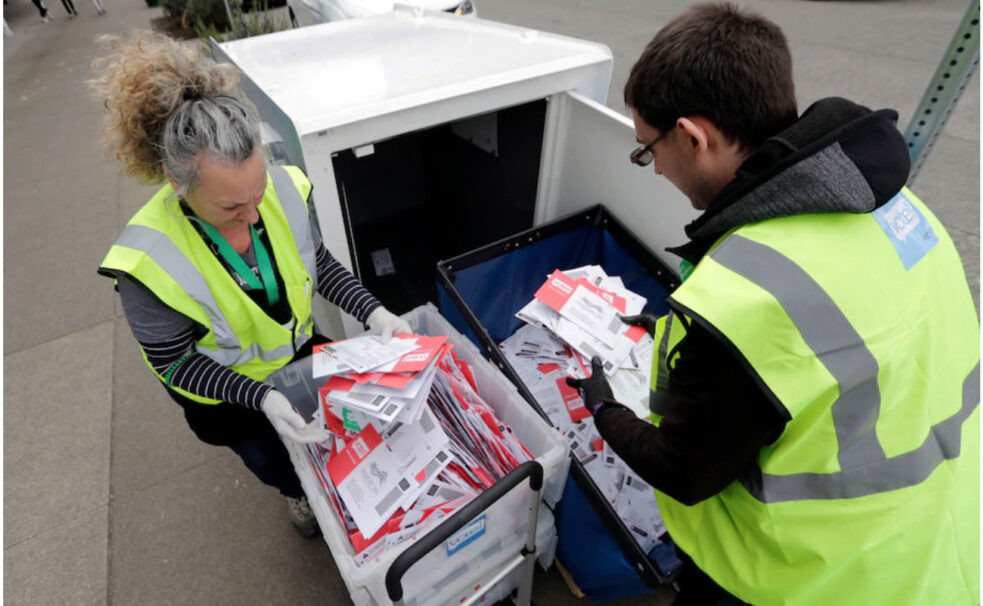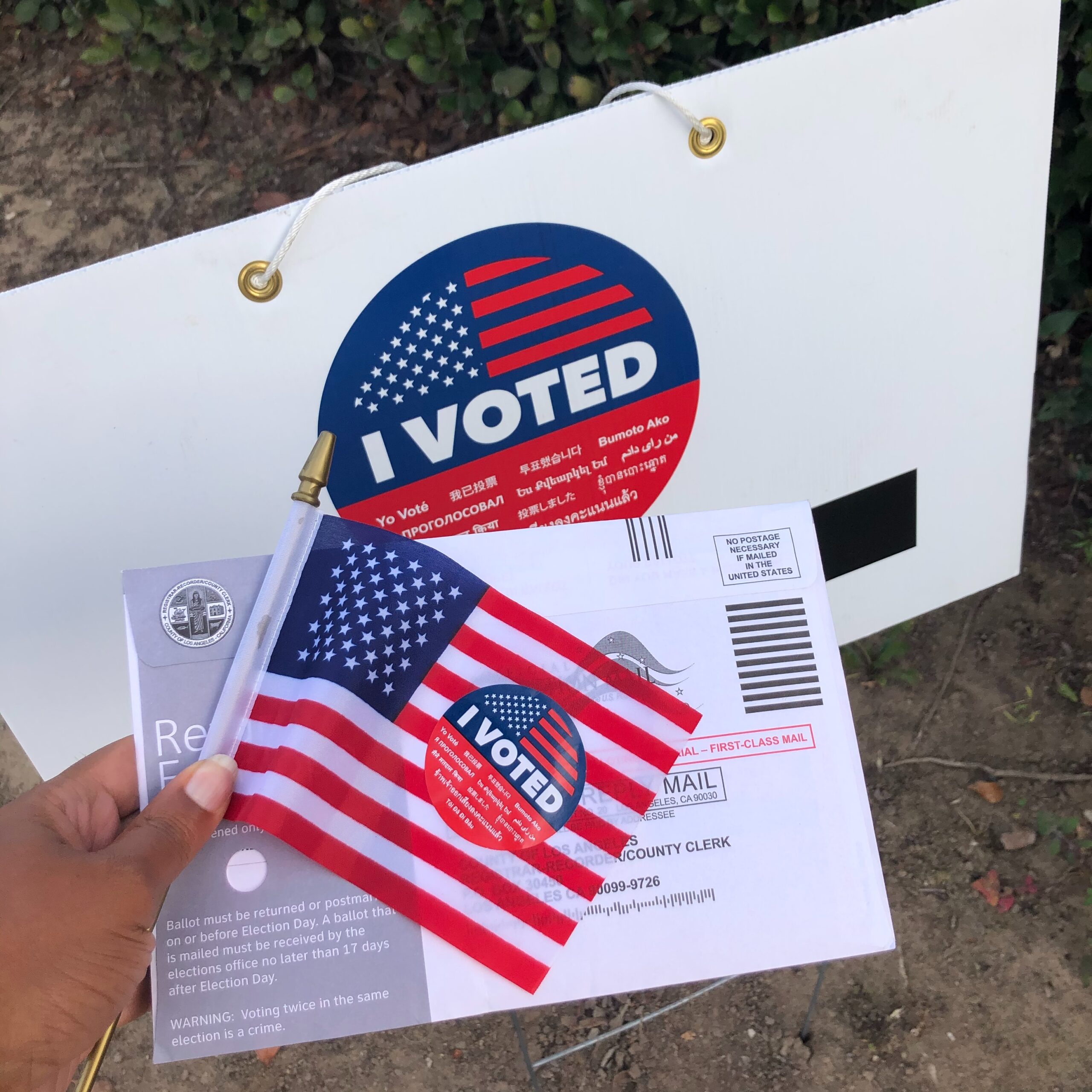WBUR – A voting rights bill designed to ensure that mail-in ballots and early voting become permanent fixtures in future Massachusetts elections was signed into law Wednesday by Republican Gov. Charlie Baker.
Bill to Bypass Constitution, Create Vote-By-Mail System Passes Committee
Town Square Live – A bill to bypass the need to amend Delaware’s Constitution and cement no-excuse absentee ballots in future elections was released from a House Committee Wednesday despite objections from Republicans.
Vote-By-Mail Bill Passes in Marathon State Senate Session
Delaware Public Media – Senate lawmakers worked past midnight to pass legislation making voting by mail a permanent feature of Delaware’s elections.
Bill Ensuring Mail-in Ballots, Early Voting Heads to Baker
AP — A voting rights bill that would ensure mail-in ballots and early voting become permanent fixtures in future elections is headed to Republican Gov. Charlie Baker’s desk after the Massachusetts House voted 126-29 to approve the measure on Thursday.
Election Officials Have Multiple Safeguards in Place to Keep Voting Secure
The U.S. Cybersecurity and Infrastructure Security Agency (CISA) issued an advisory Friday about vulnerabilities affecting versions of Dominion Voting Systems Democracy Suite ImageCast X, an in-person voting system used in local jurisdictions across the country. Yes, that Dominion Voting Systems that has been a target of people pushing false stolen-election narratives. Before sounding the alarm on these systems, however, it’s important to remember the following:
First, CISA said there is no evidence that the election software flaws have been exploited to change any election results. Rather, the advisory issued today encourages officials to mitigate any identified vulnerabilities and offers suggestions for minimizing risk. In fact, in a statement to The Associated Press, CISA Executive Director Brandon Wales said “states’ standard security procedures would detect exploitation of these vulnerabilities and in many cases would prevent attempts entirely.”
Second, election officials employ myriad checks and balances, tests, and verifications before, during and after every election that — together — protect the integrity of the voting process and its underlying systems.
Every state and local election official has their own protocols and best practices to maintain the chain of custody for election materials and detect anomalies. These controls include:
- voter verification at the time of registration as well as when voters request absentee ballots;
- pre-election Logic and Accuracy testing to ensure ballot tabulation equipment is working properly;
- physical security measures, like 24/7 surveillance, witness forms elections workers must sign so officials have an auditable log of when materials and equipment were accessed and changed hands, and tamper-evident locks and seals;
- reconciliation reports that provide a daily accounting of mail ballots received; and
- post-election audits that confirm the reported results.
These measures are enhanced by cyber security protections from IT departments and federal intelligence agencies that are continuously improving their security posture in the face of threats from bad actors.
With numerous safeguards in place, voters should be confident in their election system and its outcomes.
Finally, expanding access to mail ballots may actually improve security, despite persistent misinformation and disinformation to the contrary. Vote-by-mail systems also benefit from the protections U.S. Postal Inspectors provide in ensuring the integrity of the U.S. Postal Service and its ability to deliver democracy to voters across the country.
In seven states, every voter automatically receives a paper ballot by mail for every election, which they mark by hand and return by mail, official drop box, or in person to their elections office. And in 27 more states, voters do not need an excuse to obtain a mail ballot.
Vote-by-mail is secure and still preserves accessible options for voters with disabilities to use assistive voting devices. Plus, it’s a transparent process with a verifiable paper trail that instills confidence in voters — especially when ballot tracking coupled with robust curing programs are in place that allow officials to investigate missing or unmatched signatures and offer voters the opportunity to remedy errors. More states and local jurisdictions should consider embracing expanded mail-ballot access with signature curing as a proven, secure voting option.
###
Lori Augino is the executive director of National Vote at Home Institute, a nonpartisan nonprofit dedicated to access to and confidence in voting by mail. Previously, she served as the president for the National Association of State Election Directors from 2020 to 2021 and as the state elections director under former Republican Washington Secretary of State Kim Wyman.
Power of Mailed-Out Ballots Clear in May Primaries
Oregon, a model vote-at-home state, has experienced the greatest overall turnout thus far at 37%, and turnout in Nebraska’s 11 full vote-at-home counties was more than 20 percentage points higher on average than the state’s total turnout.
With over a quarter of the 2022 primaries in the books, one trend is unmistakable: states and jurisdictions that automatically mail ballots to their voters experience higher turnout than states with more restrictive mail-ballot access.
Oregon, with its full “vote at home” model in which all active registered voters are mailed their ballots automatically for every election, shows the highest turnout of any state to date at 37.1%. This is more than 10% higher than the average for the remaining 12 states that have held primaries to date.
Even more striking is turnout in the Democratic and Republican primaries. Oregon is a “closed primary” state, meaning only Republicans and Democrats can participate in their respective party elections. Turnout currently stands at about 53% for Republicans and 50% for Democrats. Those rates are more than double the total turnout in many states where all voters were eligible to participate.
“When ballots are placed directly in the hands of voters, they turn out,” said Lori Augino, executive director for National Vote at Home Institute and former Washington state elections director. “Automatically mailing a ballot to voters several weeks before the election gives them the time and convenience they need to vote, without having to overcome unnecessary barriers like requesting a mail ballot or obtaining a witness or notary signature.”
Comparing other major “closed” primaries, the most relevant may be Pennsylvania, with several scorching statewide races in play, including the gubernatorial and Senate contests. Total turnout was well below Oregon’s, coming in at 30%, and party-specific turnout was also far less with about 39% for Republicans and 32% for Democrats.
About 5% behind Oregon’s overall turnout and holding the second-highest primary turnout to date is Nebraska, an open-primary state with 11 counties using the vote-at-home model in which every active registered voter is automatically mailed a ballot. Those counties came in at an average 55% turnout, more than 20 percentage points higher than the statewide total.
| State | Mailed-out ballot policy | Closed or Open primary | Total 2022 primary turnout | Republican Party turnout | Democratic Party turnout |
| Oregon | Vote-at-home (VAH) | Closed | 37% | 53% | 50% |
| Pennsylvania | No-excuse absentee | Closed | 30% | 39% | 32% |
| Nebraska* | No-excuse absentee | Open | 33% | 40% | 29% |
| *NE 11 VAH counties only | Vote-at-home (VAH) | Open | 55% | 55% | |
Sources: Secretaries of state websites and published media reports.
Almost a third of the states had lower than 20% turnout.
All except North Carolina require voters to have an excuse to obtain a mailed-out ballot, and North Carolina’s witness/notary requirements create an additional obstacle for people to vote using mail ballots.
| State | Mailed-out ballot policy | Total 2022 primary turnout |
| Indiana | Excuse required | 14.0% |
| Texas | Excuse required | 19.0% |
| Kentucky | Excuse required | 19.0% |
| North Carolina | No-excuse absentee, but requires two witnesses or a notary | 19.7% |
Sources: Secretaries of state websites and published media reports.
“The key difference between these states and those with greater turnout are their policies on access to mailed-out ballots,” said Augino. “Unfortunately, these states impose additional barriers to voters in obtaining mail ballots, which makes voting less convenient and ultimately discourages participation.”
Turnout in Counties With All-Mail Elections Far Exceeds Statewide Average
Lincoln Journal Star — Voter turnout in Nebraska counties that conduct elections exclusively by mail reached 55% during the May 10 primary, exceeding the overall voter participation rate of 33.3%, an analysis of the results shows.
Ballot Tracking Can Improve Rejection-Rate Disparities
The Seattle Times — As disinformation about the 2020 election and the security of vote-at-home elections persists, instilling public confidence is critical. Washington voters have every reason to be confident in their election system, and every reason to continue to improve it.
Washington is one of only eight states that automatically sends a ballot to their voters for every election, it routinely boasts some of the nation’s highest turnout, and it was the only state in 2020 to receive a perfect score from Brookings Institute for its preparedness for voting during a pandemic. Not to mention the state has been on the cutting edge of election innovations, from being one of the first states to adopt mail-in balloting to implementing same-day and automatic voter registration and the Future Voter program.
As the pandemic began to take shape in 2020, states and local jurisdictions from across the country looked to Washington state’s election officials for expertise and advice for ramping up their mail-ballot programs in the midst of a global health crisis. In fact, National Vote at Home Institute regards Washington as a model state for vote-at-home (or vote-by-mail) elections systems. Thanks to its mail-ballot accessibility and system resilience, the state in 2020 saw its highest turnout on record for a statewide primary in more than a half-century and near-record turnout in the general election.
However, a recent performance audit by the Washington State Auditor’s Office found that during the 2020 general election, the ballots of young voters, male voters and voters of color were more likely to be rejected due to voter-signature issues than other racial and demographic groups. Troublingly, the ballot rejection rate for Black voters was 2.49%, 1.59% for Native Americans, 1.57% for Hispanics, 1.24% for Asian/Pacific Islanders and 0.63% for white voters. And voters under the age of 26 accounted for more than 30% of rejected ballots.
The overall rejection rate was less than 1%, and the audit found no evidence of bias in decisions to accept or reject ballots. Nonetheless, state and local election officials agree the disparities warrant further examination. In fact, the Office of the Secretary of State requested that the state Legislature fund a study through the University of Washington’s Evans School of Public Policy and Governance to evaluate the audit’s recommendations.
The audit outlined several innovations election officials could adopt to increase the chances of curing challenged ballots, and among the innovative practices recommended was robust ballot tracking.
Today, Washington voters can check the status of their ballot by logging in to VoteWA.gov. This lookup tool provides voters an opportunity to see when their ballot is on its way to them, when it has been received by their county elections office and whether it has been accepted or challenged (and ultimately, rejected). With end-to-end ballot tracking, however, voters are proactively notified via email and/or text by their local elections office when their ballot is out for delivery, when it has arrived at their home, when it has been received by the election office and when it has been accepted. If the ballot is not accepted, the ballot tracking service can quickly relay instructions to voters on how to cure their ballot so it may be accepted and counted. The system can even be configured to alert voters of upcoming elections, deadlines and other important voting information.
To eliminate voting disparities and stay ahead of the curve, the Washington Office of the Secretary of State is considering this innovation, which is currently used in three of the nation’s eight vote-at-home states as well as in many jurisdictions across the U.S. It’s convenient, transparent and accessible, much like tracking an online order. Plus, participating in ballot tracking programs has been shown to boost turnout by as much as 20%.
Before the Secretary of State’s Office could implement ballot tracking, migrating each of Washington’s 39 county election offices to VoteWA, the state’s voter registration and election management system launched in 2019, was crucial. With VoteWA now well-established, the secretary’s office is poised to develop an end-to-end ballot tracking system to serve voters statewide.
Washington state is home to some of the most accessible and secure elections in the country. Voting at home remains a time-tested, fair way to improve access and increase turnout across demographics. Implementing some of the recommendations from the audit, including robust ballot tracking, would serve to further enhance voters’ experience with and confidence in their elections system, and could turn the tide on some of the disparities in ballot-rejection rates.
###
Pat McCarthy is the Washington state auditor.
Steve Hobbs is Washington’s Secretary of State.
Lori Augino is the executive director for the National Vote at Home Institute, a nonpartisan, nonprofit dedicated to expanding vote by mail.
Ballot Tracking Can Improve Rejection-Rate Disparities
The Seattle Times – As disinformation about the 2020 election and the security of vote-at-home elections persists, instilling public confidence is critical. Washington voters have every reason to be confident in their election system, and every reason to continue to improve it.
The Faulty Premise of the ‘2,000 Mules’ Trailer About Voting by Mail in the 2020 Election
Politifact — “2000 mules,” a new documentary from a right-wing filmmaker with a history of spreading false claims, promises to give evidence to millions of Americans who believe something went wrong in the 2020 election.









